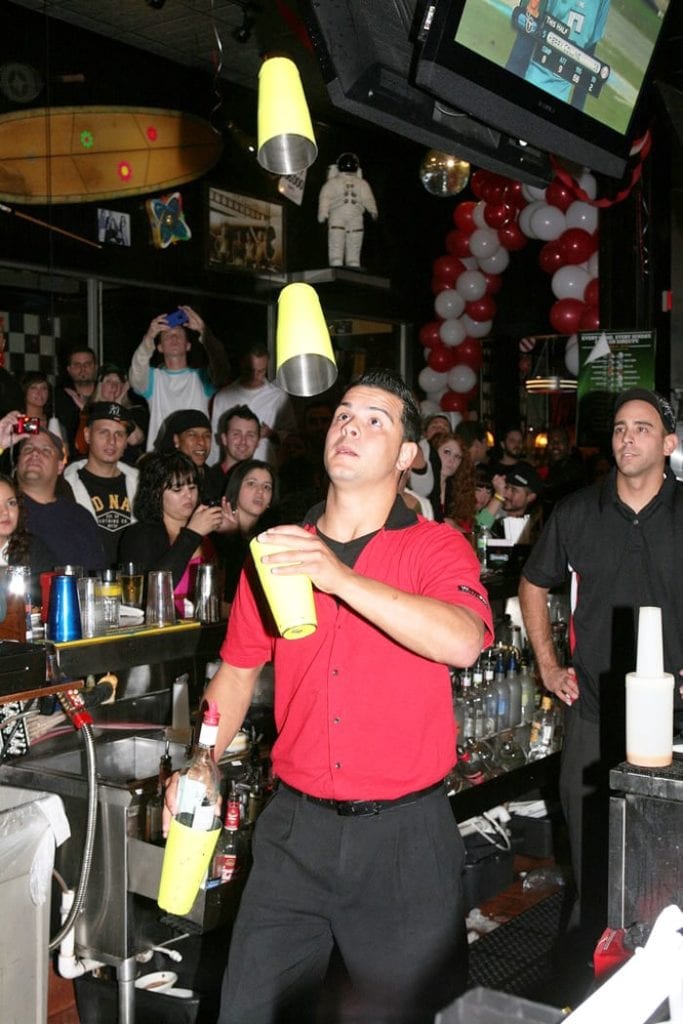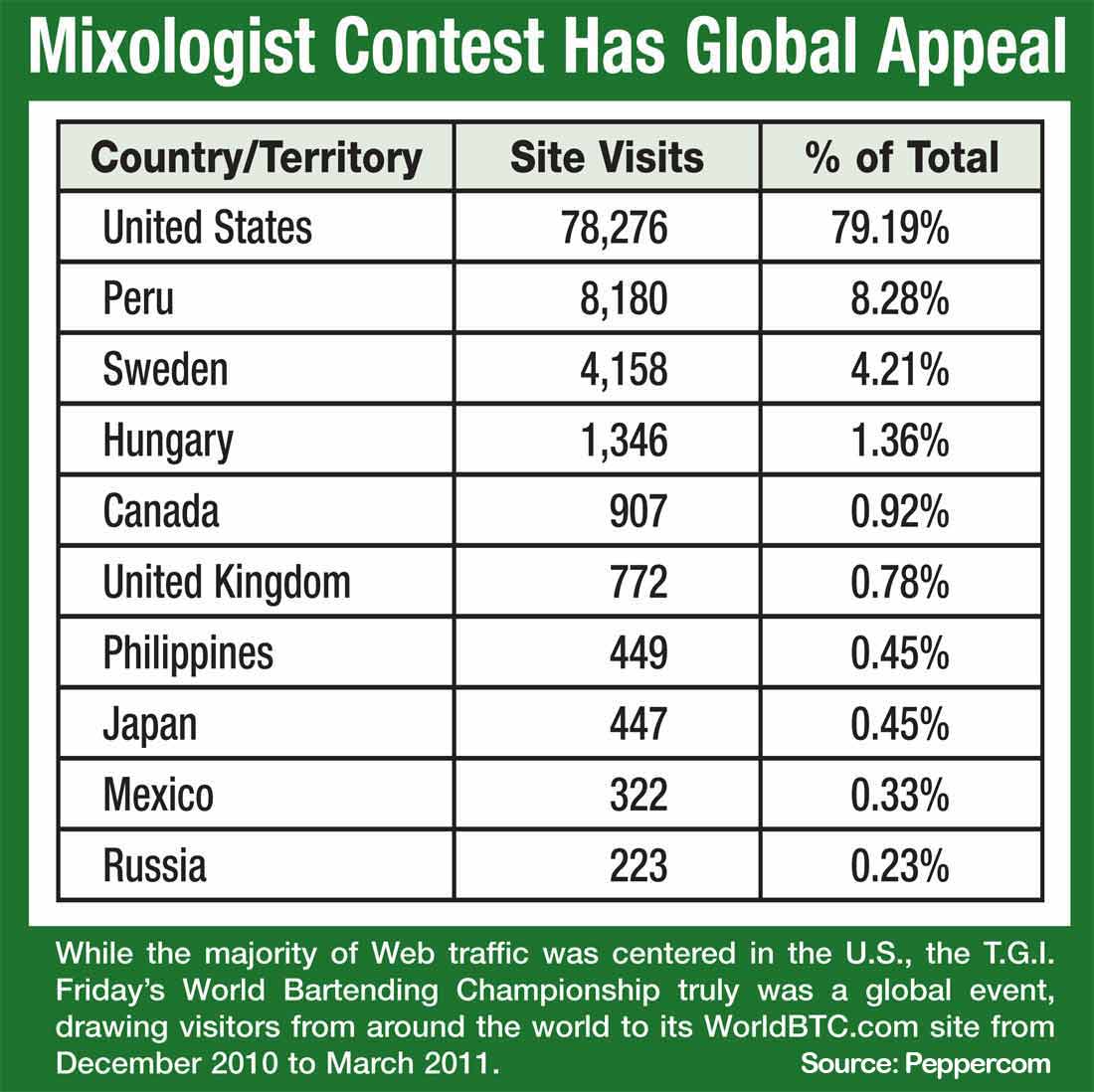 |
| “Would you like an olive with that?” A T.G.I. Friday’s bartender mixes it up during the World Bartender Championship competition. Photo courtesy of Peppercom |
Company: T.G.I. Friday’s
Agency: Peppercom
Timeframe: Sept. 2010 - Present
In the 1988 film Cocktail, Tom Cruise—in the role of Brian Flanagan—learned the tricks of the bartender trade, including “fairing” with shakers and bottles to dazzle his customers, from his mentor while working at a T.G.I. Friday’s. In 2010, with the spirit of Flanagan’s audacious bartending performances and a lineage of talented Fridays’ bartenders, T.G.I. Friday’s and PR agency Peppercom launched a multi-tiered campaign for the 20th annual World Bartender Championship (WBC) season to refresh the event and make it more relevant to consumers.
“The Friday’s brand is all about creating an infections energy and laid-back atmosphere for guests,” says Shannon Gewinner, vice president of brand marketing for T.G.I. Friday’s. “Serving unique drinks and cocktails is certainly part of that commitment, which—combined with our heritage and innovation in the bar and beverage industry—led us to create the WBC 20 years ago,” says Gewinner. For the 20th season, to start at the end of 2010 and finish in March 2011, an integrated team of 10 Peppercom and five T.G.I. Friday’s communications pros drafted the following goals:
• Raise awareness of the competition with guests and consumers outside the organization. Already a successful internal program, Gewinner says they wanted to engage fans like never before, particularly at a more national level.
• Elevate the “sport” of bartending. Send the half-serious message that the training and skill set required to compete in the WBC is on par with Olympic athletes.
• Drive traffic to T.G.I. Friday’s restaurants and bars.
• Ensure that Friday’s is associated with having the best bartenders in the world, connecting them to the overall brand commitment of creating an infectiously fun environment.
Ed Moed, cofounder and managing partner of Peppercom, says that the WBC was already an established 20-year asset for Friday’s, and that the agency’s overall objective was to enable people to see that Friday’s is “the greatest bartending restaurant in the word,” he says. Primary research for the campaign was conducted by surveying the Friday’s bar audience—people ages 21-34—to get their perspective to help drive the campaign’s messaging.
 |
SERVING UP STRATEGY
The campaign was structured around a three-part initiative:
1. Create a humorous theme that ties into the irreverent tone of the Friday’s brand. To drive bartending as a sport—specifically, an Olympic sport—the team would use digital/social media engagement and media relations outreach during the events leading up to the WBC, both at the local and national levels.
2. Drive home the Olympics initiative and develop a robust online messaging platform in order to reach Friday’s target audience where they live, work and play.
3. Drive traffic to the restaurants through local WBC events, encouraging fans to attend their local Friday’s to watch the bartenders progress through the competition.
ATTRACTING THE MEDIA
For Friday’s bartenders to make it all the way to the March WBC championships in Dallas, each server must compete at their individual franchise level; a regional competition; and in one of six divisional competitions held in New Jersey, Baltimore, Orlando, Las Vegas, Minneapolis and Dallas. “When Friday’s hired us in September 2010, it was only right before the regional level of the competition, so we immediately started to promote the local regional competitions through media outreach, pitching blogs and other online outlets,” says Rebecca Maas, account supervisor at Peppercom.
The team worked with local news crews to obtain coverage for these six events and hired photographers as well. “We coordinated synchronized flare [ Ed. Note —as in fire] routines to showcase the bartenders’ talent, and had the photographers at the events filming with some of the actual consumers and fans who were there to cheer on their local bartenders,” says Maas. Clips were then compiled and posted to YouTube and a microsite so that consumers could view as they were voting for bartender to advance in the competition.
ADVOCACY: ONLINE & OFF
A dedicated microsite—WorldBTC.com—was created in September 2010 to increase awareness of the WBC and its competitors as part of a public advocacy campaign for bartending to be considered as an Olympic sport, says Gewinner. Fans were directed to the site via a link on the Friday’s Facebook page and through a new @TGIFridays Twitter handle, which the Peppercom team started. (For more on guiding a public advocacy campaign, see the sidebar.)
To kick off the Olympic push, an ironic letter was drafted with 2009 World Bartender Champion Brian Zachau—named honorary chairman of the WBC—and sent to International Olympic Committee President Jacques Rogge and members of the IOC to request that the sport of bartending be recognized as an Olympic athletic competition for the 2012 games in London and beyond. ( “Like a fine wine, the sport of bartending has come of age—and fans across the globe thing its time for it to be recognized as an Olympic sport,” the letter said.)
The challenge there, says Moed, was walking the tightrope of tying in the irreverent Friday’s brand while adhering to the regulations and rules about what actually constitutes an Olympic sport. The letter was leveraged into a petition that was hosted on the site, which fans were encouraged to sign to show their support.
The site also featured behind-the-scenes video clips demonstrating the training required for competing in the WBC. As the competition season progressed, photos and clips of the local competition were added as well as clips under the Olympic banner. “We created really fun videos with bartenders lifting kegs of beer like they would barbells and sliding pints of beer down a long bar like they would if they were curling,” says Moed.
A “Fan Fave” Contest was promoted on the site, where consumers could vote for their favorite bartender out of the final 10 competing in Dallas. This engaged fans beyond the local competitions and made them part of the process during the run to the finals.
MORE MEDIA BUZZ
As the competition progressed, a layered media relations campaign featured national, local and social media outreach. Working with the previous WBC winner Zachau, a media tour was executed which resulted in interviews with Bloomberg TV, The Mancow Experience radio show, Zagat’s blog, NBC Sports and The Washington Post. Outreach culminated with a local media blitz in Dallas in the week of the finals in March 2011.
“We wanted to create buzz around the campaign, but not just for the sake of creating buzz,” says Gewinner, adding that one of the campaign’s primary goals was to increase traffic to the restaurants.
For Moed, the most difficult aspect was getting the messaging right in social media. “With a campaign like this, we had to balance the seriousness in that bartenders are genuinely talented, what the WBC means to Friday’s brand, while also implementing some tongue-in-cheek elements,” says Moed. “We had to experiment a little to hit the right tone with our consumers.”
MAKING A SPLASH
While bartending won’t be on the docket for the 2012 Olympics in London (no new sports were added), the campaign did achieve the following:
• More than 20,000 petition signatures were gathered
• 100,000-plus people voted in the “Fan Fave” contest
• More than 100 million media impressions were garnered
• More than 2,000 Twitter followers were acquired, with consistent growth month over month of 30-50%
• The Web site saw nearly 200,000 page views.
• The contest attracted 137,000 Facebook impressions
• 5,000 Friday’s discount coupons were distributed via Olympic Street Teams
• Through social media and in-restaurant events, T.G.I. Friday’s enjoyed higher guest counts during the peak WBC contest months, says Gewinner.
Moed says that his team wishes it could have started three months earlier during the initial rounds of the competition, but notes that for next year’s campaign, Peppercom will capitalize on those extra months to plan for more local/regional initiatives.
Moed adds that they’re considering taking the WBC to television. Can you say, Cocktail 2, the Series? PRN
CONTACT:
Rebecca Maas, [email protected]. Ed Moed, [email protected], Shannon Gewinner, [email protected]; Mindy Finn, Mindy Finn, [email protected].
